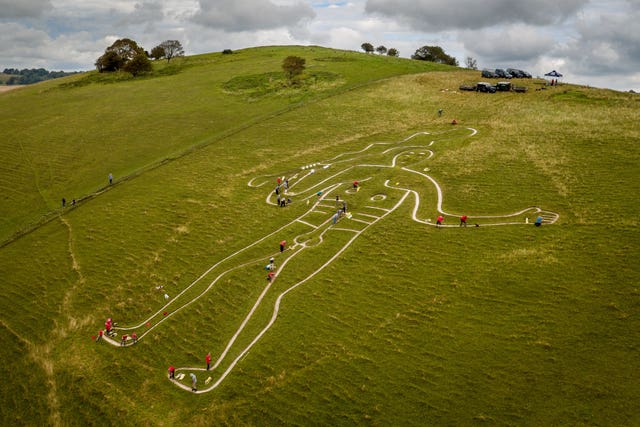180ft hillside chalk giant to be refreshed by team of volunteers
Cerne Abbas Giant in Dorset needs a refresh after being weathered over the past decade.

A giant chalk figure that is thought to have loomed large on a country hillside since the 17th century is being given a makeover.
The world famous Cerne Abbas Giant in Dorset is 60 metres (180ft) long and will be re-chalked by hand by dozens of volunteers over the next two weeks.
Since its last refresh in 2008, the weather has taken its toll and weeds have encroached on the Giant, blurring its previously sharp outline.
The Giant was given to the National Trust to look after in July 1920 by the Pitt-Rivers family, and the Trust is planning a year of celebrations next year to mark the centenary.
Natalie Holt, countryside manager for the National Trust, said: “Re-chalking the Giant is challenging in many ways, not only due to its size but because of the sheer steepness of the slope he’s on.
“It needs re-doing every 10 years or so because he does get discoloured and weathered and covered in weeds.
“The first job is to dig out all the old chalk before hammering in 17 tonnes of new chalk.
“The Giant is vulnerable to erosion from rainwater which can collect in its chalk outline and run down the hill at speed.

“When we’re happy we’ve done a really good job of packing the chalk, we will leave him alone – and tamper with him as little as possible – to preserve him for another decade.
The Giant lies on high quality chalk grassland – a Site of Special Scientific Interest – that has a huge range of wildflowers including a variety of orchids, thyme, marjoram and small scabious. It is also an important site for butterflies including the Marsh Fritillary and Duke of Burgundy.
The origin of the ancient figure – which stands naked and brandishes a 40 metre (120ft) long club – remains shrouded in mystery, with ideas ranging from a depiction of ancient gods to aiding fertility.
Mike Clark, from the Cerne Historical Society, said: “There are many different theories surrounding the Giant’s identity and origin.
“Some claim he is an ancient symbol, perhaps a likeness of the Greco-Roman God Hercules, though the earliest recorded mention of the Giant only dates from 1694.

“Local folklore has also long held him to be an aid to fertility.”
Miss Holt added: “We are constantly reviewing how best to look after the Giant so that he can be enjoyed by visitors for many years to come.
“We know that the impacts of climate change, should we experience more frequent and severe rains, may mean it requires more frequent chalking.
“We may also have to alter the timing, duration and number of sheep grazing the hillside in order to keep the grass short enough so the giant can be seen.
“This in tandem with maintaining a flower-rich chalk downland could be a tricky balance to find.”





